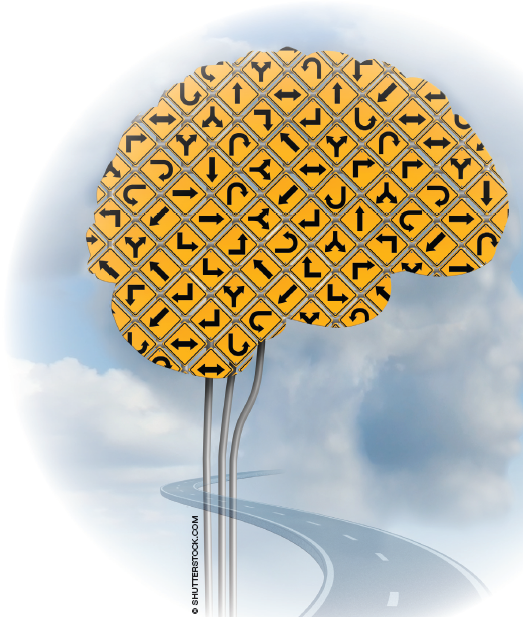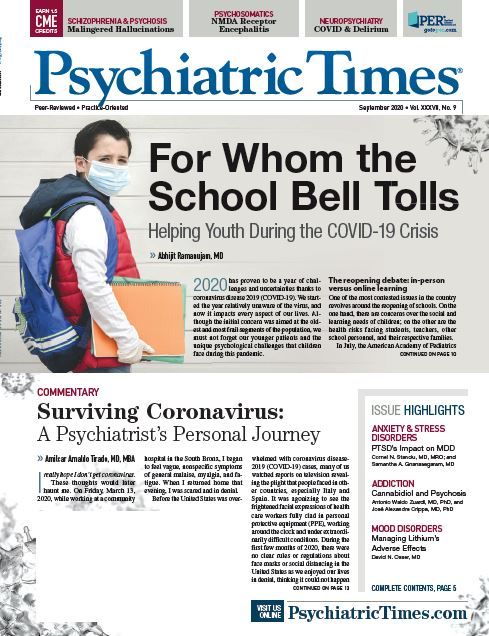Publication
Article
Psychiatric Times
Exploring the Relationship Between Cannabidiol and Psychosis
The acute psychotomimetic effect of cannabis is transitory, but evidence indicates that the chronic use, especially if started in adolescence, contributes to the occurrence of schizophrenia.

CLINICAL
The association between Cannabis sativa (cannabis) and psychosis goes back at least as far as the Pen-ts’ao Ching, the world’s oldest pharmacopeia, which is attributed to the Chinese emperor Shen-Nung (circa 2700 BC). It says, “ma-fen [the fruit of cannabis] if taken in excess will produce visions of devils . . . over the long term, it makes one communicate with spirits.”1 In the West, cannabis was used as an experimental psychotomimetic in the 19th century by pioneering French psychiatrist Jacques-Joseph Moreau, and it continues to be used to this day.1,2 Cannabis’ acute psychotomimetic effect is transitory; however, consistent evidence indicates that the chronic and intense use of the plant, especially if started in adolescence, contributes to the occurrence of schizophrenia.3
We know that cannabis contains about 100 cannabinoid compounds and that the psychotomimetic effects of the plant are induced by tetrahydrocannabinol (THC).4 However, we have also known since the early 1970s that the effects of cannabis cannot be attributed solely to THC.5 Other cannabinoids, including cannabidiol (CBD), have intrinsic actions as well.6
Antipsychotic properties
In 1982, a study of the interactions between THC and CBD in healthy volunteers provided the first evidence that CBD might have antipsychotic properties. Our group administered oral CBD concomitantly with a high dose of THC to investigate whether CBD could attenuate THC-induced anxiety. Surprisingly, in addition to alleviating anxiety, CBD reduced the psychotic symptoms commonly induced by THC.7
More recently, this observation was confirmed in a study with THC administrated intravenously after oral pretreatment with CBD or placebo.8 In addition to blocking the psychotic symptoms induced by THC, CBD and THC presented opposite effects relative to placebo in terms of activation of the striatum during verbal recall, as assessed by functional MRI.
The early observation that CBD reduced THC-induced psychotic symptoms led us to carry out a pioneering study to test the effects of CBD in a model commonly used to identify drugs with an antipsychotic profile in laboratory animals.9 The stereotypy induced in rats by a dopaminergic agonist was clearly reduced by CBD, without producing the catalepsy that is associated with the extrapyramidal adverse effects (AEs) of classical antipsychotic drugs. This finding suggests that CBD has an atypical antipsychotic pattern. A series of other tests with different animal models confirmed and expanded the antipsychotic profile of CBD.10
Effects on schizophrenia
The next step was to evaluate the effects of CBD in a patient with schizophrenia. The patient was a woman with chronic psychosis who experienced many AEs with traditional antipsychotics, which provided the ethical justification for this first clinical test. After 4 weeks of treatment, the patient had a marked reduction in her psychotic symptoms as assessed by standardized rating scales. This published case report stimulated the undertaking of randomized controlled clinical trials (RCTs).11
To date, 3 RCTs have evaluated the therapeutic effects of CBD in patients with schizophrenia. The first one, using a double-blind procedure, included 39 patients treated with either CBD (800 mg/day; n = 20) or the atypical antipsychotic amisulpride (800 mg/day; n = 19) for 4 weeks. The 2 drugs led to similar significant reductions in both positive and negative psychotic symptoms, but fewer AEs were seen in the CBD group.12
In the other 2 RCTs, CBD was administered as an adjunctive treatment for 6 weeks with placebo control; however, the results were contradictory. CBD treatment (1000 mg/day; n = 42) was associated with a significant reduction in positive symptoms from baseline to the end point compared with placebo (n = 44) in one study (Figure 1).13 Results from the other RCT, which used a very similar methodology but a lower CBD dose (600 mg/day; n = 20), found no significant symptomatic differences between treatments with CBD and placebo (n = 19).14 A possible explanation for the contradictory results may be the 400-mg difference in daily CBD doses.
Anxiolytic effects of CBD
The CBD dose-response relationship appears to have a particular feature. The anxiolytic effects of CBD, described in the early 1980s and confirmed by later animal and human studies, clearly follow this dose-response pattern.15 In 1990, CBD was tested in a range of doses in rats with the elevated plus-maze model and was found to act according to a bell-shaped dose-response curve. CBD induced an anxiolytic-like effect only at intermediate doses.16
This dose-response curve was also observed in healthy volunteers subjected to anxiety via a public speaking test and by public speaking in real-world settings.17,18 In both situations, treatment with CBD 300 mg was associated with significant decreases in anxiety symptoms, but this effect was not observed with lower or higher doses.
The same response pattern was observed in preclinical tests using other models of induced anxiety, cognitive impairment, and schizophrenia-like behavior.18 The findings suggest that this inverted U-shaped curve response pattern may be extended to other therapeutic effects of CBD, with different effective doses and therapeutic windows for each condition.
Accordingly, data from the 3 previously mentioned CBD RCTs suggest that the dose range to reduce psychotic symptoms (probably between 800 and 1000 mg/day), but not cognitive symptoms, should be higher than that used to induce anxiolytic effects (between 200 and 400 mg/day). However, precise dose ranges for each condition or symptom are yet to be determined in future RCTs with larger samples, different clinical populations, and multiple doses.
Parkinson psychosis
It seems that the antipsychotic effect of CBD is not limited to patients with schizophrenia. Antipsychotic effects of CBD (150 mg to 400 mg/day) were seen in patients with Parkinson disease who, for at least 3 months, had psychotic symptoms that could not be controlled by reducing antiparkinsonian drug regimens.19 We observed a reduction in psychotic symptoms (Figure 2) in addition to a significant improvement in global functioning (as assessed with the Unified Parkinson’s Disease Rating Scale and the Clinical Global Impression Scale).
This important study paved the way for a new, double-blind, placebo-controlled RCT with parallel groups of patients with Parkinson treated with 2 doses of CBD (75 mg and 300 mg/day) for 6 weeks. Patients with dementia or psychotic symptoms were excluded from the study to avoid the influence of psychotic symptoms. The results showed that CBD induced a significant improvement in nonmotor symptoms, including daily life activities and rapid eye movement sleep behavior disorder.20
CBD presents multiple actions in the central nervous system that may have a crucial role in the pharmacotherapy of the motor and nonmotor effects of Parkinson disease. This cannabinoid was shown to have neuroprotective properties by enhancing the recycling of old/damaged cell components via the facilitation of autophagic action.15 Moreover, CBD exerts antioxidant activities, stimulates neurogenesis, regulates mood and sleep, improves cognition and motor activity, and restores dendritic arbor and brain-derived neurotropic factor levels in the hippocampus.10
Mechanisms of action
The specific pharmacological mechanisms underlying the antipsychotic action of CBD are not fully understood, as this compound seems to interfere with neurotransmitter systems in diverse ways.10 For instance, CBD inhibits the reuptake and metabolism of anandamide, which may be implicated in the antipsychotic effect of CBD, as the concentrations of this endocannabinoid in the cerebrospinal fluid of patients with schizophrenia are higher than in those of controls and are inversely correlated with psychotic symptoms. It suggests a feedback mechanism in which the anandamide increase outweighs the occurrence of psychotic symptoms. Moreover, patients with prodromal psychosis present higher anandamide levels in cerebrospinal fluid (CSF) than do controls.12 The clinical improvement produced by CBD in the patients with schizophrenia has been linked with increased CSF anandamide levels. The effects of CBD on anandamide regulation in different brain regions associated with the pathophysiology of schizophrenia could explain its antipsychotic action.8
Further mechanisms that could clarify the antipsychotic action of CBD include its ability to increase hippocampal neurogenesis and neuroprotection; its interaction with 5HT1A, GPR55, and TRPV1 receptors; and its antioxidant and anti-inflammatory effects. For instance, some second-generation antipsychotics, such as ziprasidone and aripiprazole, also activate 5-HT1A receptors, which may, at least in part (in addition to the noninvolvement of dopamine antagonism), explain the absence of extrapyramidal AEs of CBD.10
Conclusions
Research has been conducted on CBD and its potential use for neuropsychiatric conditions such as schizophrenia, anxiety, Parkinson disease, depression, and dystonia, as well as for diseases and conditions that involve other organs and systems, such as inflammation, immune response, ischemia, diabetes, cancer, and many others. Most of this are preclinical studies in laboratory animals.15
The only CBD formulation approved by the FDA is Epidiolex (GW Pharmaceuticals) to treat rare forms of epilepsy in children and adolescents; it is not currently available for use in schizophrenia. Although there are controlled good laboratory and manufacturing practices, and purified synthetic analogues for CBD exist, further safety and efficacy studies are needed.
CBD can be easily purchased throughout most of the United States, which raises concerns about the use of handcrafted, uncontrolled, cannabis-enriched CBD. However, there are well-known harmful long-term effects of THC on the developing brain, cognitive impairments associated with cannabis, and worsening of psychotic symptoms and antipsychotic response, particularly in younger patients. Therefore, well-designed RCTs with larger patient samples, using high-quality and reliable CBD, are needed to ascertain the effectiveness and safety of CBD as an antipsychotic medication and to ultimately receive FDA approval for use in schizophrenia.
Dr Zuardi is a full professor, Department of Neuroscience and Behavior, Ribeirão Preto Medical School, University of São Paulo, Brazil. Dr Crippa is a full professor, Department of Neuroscience and Behavior, School of Medicine of Ribeirão Preto, University of São Paulo, Brazil, and a member of the National Institute of Science and Technology for Translational Medicine, Brazilian National Council for Scientific and Technological Development, Brasília, Brazil. In addition, Dr Crippa is a member of the International Advisory Board of the Australian Centre for Cannabinoid Clinical and Research Excellence.
The authors report that they are coinventors of the patent “Fluorinated CBD compounds, compositions and uses thereof.” They are also recipients of Conselho Nacional de Desenvolvimento Científico e Tecnológico productivity fellowships. In addition, Dr Crippa has received travel support from BSPG Laboratories, Ltd, and has received a grant from the University Global Partnership Network to establish global priorities in cannabinoid research excellence.
An earlier version of this article appeared online as Understanding the Relationship Between Cannabidiol and Psychosis: Clinical Issues, posted on June 17, 2020. -Ed
References
1. Zuardi AW. History of cannabis as a medicine: a review. Braz J Psychiatry. 2006;28(2):153-157.
2. D’Souza DC, Abi-Saab WM, Madonick S, et al. Delta-9-tetrahydrocannabinol effects in schizophrenia: implications for cognition, psychosis, and addiction. Biol Psychiatry. 2005;57(6):594-608.
3. Marconi A, Di Forti M, Lewis CM, et al. Meta-analysis of the association between the level of cannabis use and risk of psychosis. Schizophr Bull. 2016;42(5):1262-1269.
4. Mechoulam R, Hanus LO, Pertwee R, Howlett AC. Early phytocannabinoid chemistry to endocannabinoids and beyond. Nat Rev Neurosci. 2014;15(11):757-764.
5. Karniol IG, Carlini EA. The content of (–) 9 -trans-tetrahydrocannabinol (9-THC) does not explain all biological activity of some Brazilian marihuana samples. J Pharm Pharmacol. 1972;24(10):833-834.
6. Cunha JM, Carlini EA, Pereira AE, et al. Chronic administration of cannabidiol to healthy volunteers and epileptic patients. Pharmacology. 1980;21(3):175-185.
7. Zuardi AW, Shirakawa I, Finkelfarb E, Karniol IG. Action of cannabidiol on the anxiety and other effects produced by delta 9-THC in normal subjects. Psychopharmacology (Berl). 1982;76(3):245-250.
8. Bhattacharyya S, Morrison PD, Fusar-Poli P, et al. Opposite effects of delta-9-tetrahydrocannabinol and cannabidiol on human brain function and psychopathology. Neuropsychopharmacology. 2010;35(3):764-774.
9. Zuardi AW, Rodrigues JA, Cunha JM. Effects of cannabidiol in animal models predictive of antipsychotic activity. Psychopharmacology (Berl). 1991;104(2):260-264.
10. Zuardi AW, Crippa JAS, Hallak JEC, et al. A critical review of the antipsychotic effects of cannabidiol: 30 years of a translational investigation. Curr Pharma Des. 2012;18(32):5131-5140.
11. Zuardi AW, Morais SL, Guimarães FS, Mechoulam R. Antipsychotic effect of cannabidiol. J Clin Psychiatry. 1995;56(10):485-486.
12. Leweke FM, Piomelli D, Pahlisch F, et al. Cannabidiol enhances anandamide signaling and alleviates psychotic symptoms of schizophrenia. Transl Psychiatry. 2012;2(3):e94.
13. McGuire P, Robson P, Cubala WJ, et al. Cannabidiol (CBD) as an adjunctive therapy in schizophrenia: a multicenter randomized controlled trial. Am J Psychiatry. 2018;175(3):225-231.
14. Boggs DL, Surti T, Gupta A, et al. The effects of cannabidiol (CBD) on cognition and symptoms in outpatients with chronic schizophrenia a randomized placebo controlled trial. Psychopharmacology (Berl). 2018;235(7):1923-1932.
15. Crippa JA, Guimarães FS, Campos AC, Zuardi AW. Translational investigation of the therapeutic potential of cannabidiol (CBD): toward a new age. Front Immunol. 2018;9:2009.
16. Guimarães FS, Chiaretti TM, Graeff FG, Zuardi AW. Antianxiety effect of cannabidiol in the elevated plus-maze. Psychopharmacology (Berl). 1990;100(4):558-559.
17. Linares I, Zuardi AW, Pereira LC, et al. Cannabidiol presents an inverted U-shaped dose-response curve in a simulated public speaking test. Braz J Psychiatry. 2019;41(1):9-14.
18. Zuardi AW, Rodrigues NP, Silva AL, et al. Inverted U-shaped dose-response curve of the anxiolytic effect of cannabidiol during public speaking in real life. Front Pharmacol. 2017;8:259.
19. Zuardi AW, Crippa JÁ, Hallak JE, et al. Cannabidiol for the treatment of psychosis in Parkinson’s disease. J Psychopharmacol. 2009;23(8):979-983.
20. Crippa JAS, Hallak JEC, Zuardi AW, et al. Is cannabidiol the ideal drug to treat non-motor Parkinson’s disease symptoms? Eur Arch Psychiatry Clin Neurosci. 2019;269(1):121-133.❒









